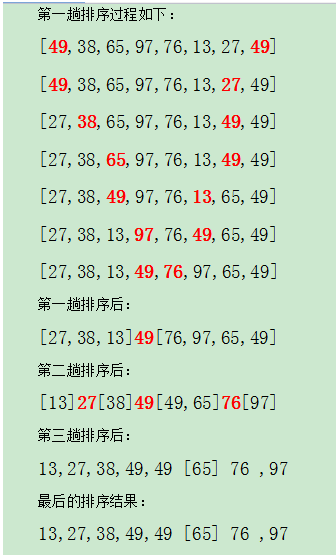1. 猴子吃桃问题:猴子第一天摘下若干个桃子,当即吃了一半,还不瘾,又多吃了一个 第二天早上又将剩下的桃子吃掉一半,又多吃了一个。以后每天早上都吃了前一天剩下的一半零一个。到第10天早上想再吃时,见只剩下一个桃子了。求第一天共摘了多少。
Method 1: 递归解决
public static int peach(int day){ int x=0; if(day==1){ x=1; }else{ x=2*(peach(day-1)+1); /* (昨天-1)的桃子=((今天-1)的桃子+1)*2s 大昨天的桃子=(昨天的桃子+1)*2 */ } return x; } public static void main(String[] args) { int x=peach(10); System.out.println(x); }
Method 2:循环解决
public static void main(String[] args) { int[] peach = new int[10]; peach[9] = 1; for (int i = 8; i >= 0; i--) { peach[i] = (peach[i + 1] + 1) * 2; //前一天摘的桃=(剩下的桃+1)*2 } System.out.println("猴子第一天摘:" + peach[0]); }

2.快速排序:

package zzsxt.cn; public class Test2 { /** * * @description: * @param a * @param low * @param high * * 快速排序的原理:选择一个关键值作为基准值。 * 比基准值小的都在左边序列(一般是无序的),比基准值大的都在右边(一般是无序的)。 * 一般选择序列的第一个元素。 * * 一次循环:从后往前比较,用基准值和最后一个值比较,如果比基准值小的交换位置, * 如果没有继续比较下一个, * 直到找到第一个比基准值小的值才交换。找到这个值之后,又从前往后开始比较,如果有比基准值大的, * 交换位置,如果没有继续比较下一个 * ,直到找到第一个比基准值大的值才交换。直到从前往后的比较索引>从后往前比较的索引, * 结束第一次循环,此时,对于基准值来说, * 左右两边就是有序的了。 * * 接着分别比较左右两边的序列,重复上述的循环。 * */ public static void sort(int[] a, int low, int high) { int start = low; int end = high; int key = a[low]; while (end > start) { // 从后往前比较 while (end > start && a[end] >= key){ // 如果没有比关键值小的,比较下一个,直到有比关键值小的交换位置,然后又从前往后比较 end--; } if (a[end] <= key) { int temp = a[end]; a[end] = a[start]; a[start] = temp; } // 从前往后比较 while (end > start && a[start] <= key){// 如果没有比关键值大的,比较下一个,直到有比关键值大的交换位置 start++; } if (a[start] >= key) { int temp = a[start]; a[start] = a[end]; a[end] = temp; } // 此时第一次循环比较结束,关键值的位置已经确定了。左边的值都比关键值小,右边的值都比关键值大,但是两边的顺序还有可能是不一样的,进行下面的递归调用 } // 递归 if (start > low)//0 sort(a, low, start - 1);// 左边序列。第一个索引位置到关键值索引-1 if (end < high)//arr.length-1 sort(a, end + 1, high);// 右边序列。从关键值索引+1到最后一个 } public static void main(String[] args) { int[] a = { 12, 20, 5, 16, 15, 1, 30, 45, 23, 9 }; int start = 0; int end = a.length - 1; sort(a, start, end); for (int i = 0; i < a.length; i++) { System.out.println(a[i]); } } }
3.选择排序:
public class TestSelectSort { public static void sort(int arr[]) { int temp = 0; for (int i = 0; i < arr.length - 1; i++) { // 认为目前的数就是最小的, 记录最小数的下标 int minIndex = i; for (int j = i + 1; j < arr.length; j++) { if (arr[minIndex] > arr[j]) { // 修改最小值的下标 minIndex = j; } } // 当退出for就找到这次的最小值 if (i != minIndex) { temp = arr[i]; arr[i] = arr[minIndex]; arr[minIndex] = temp; } } } }
4.插入排序:
public class TestInsertSort { public static void sort(int arr[]) { int i, j; for (i = 1; i < arr.length; i++) { int temp = arr[i]; for (j = i; j > 0 && temp < arr[j - 1]; j--) { arr[j] = arr[j - 1]; } arr[j] = temp; } } }